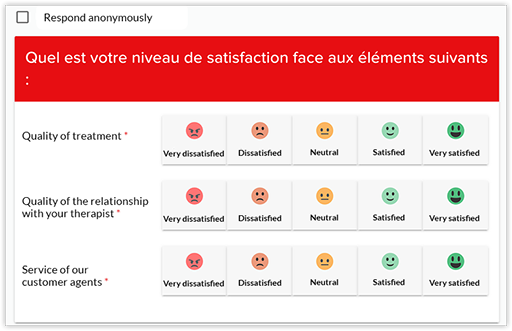As a person working in a company that interacts with customers, it is normal for you to have their satisfaction at heart. After all, you want to offer them a quality service that meets their needs. However, despite this desire to please your customers, you may have to manage customer dissatisfaction.
Download now : -> FREE FRENCH EBOOK 3 Examples of Successful Customer Satisfaction Surveys
With the myths that revolve around customer satisfaction, several completely different thoughts exist: some think that it is impossible to regain the trust of an unsatisfied customer and others think the opposite is true, as if one word of mouth can’t hurt their business. What if the answer lies in the middle? While it is possible to regain the trust of a disappointed customer, it is important to understand the impact that a dissatisfied customer can have on your brand. It is essential to know how to handle such situations! In this article, you will discover the definition of customer dissatisfaction, its various manifestations, as well as some tips to be able to manage it adequately.
What is customer dissatisfaction?
Definition of customer dissatisfaction
Despite the numerous precautions and measures put in place by your company, it sometimes happens that an error, human or technical, arrives during customer service. It is during these mistakes that customers may experience dissatisfaction with your business. However, it can be difficult to know what customer dissatisfaction is, or how to identify its effects. In this sense, it is important to understand the issues surrounding your company’s customer experience to prevent the emergence of dissatisfied customers. The customer experience should be a priority within your organization and if this is not respected, it may impact your company’s brand image and E-reputation.
Customer dissatisfaction is defined as a client’s dissatisfaction with a business experience. As a result of this bad experience, the customer may express his dissatisfaction, notably via a negative Google review, or by a direct confrontation with the company. While the situation may seem difficult to manage, it is important to identify the cause of customer dissatisfaction in order to prevent it from getting worse, at the risk of repelling potential customers or damaging your brand image.
Causes of customer dissatisfaction + some examples of customer dissatisfaction
To prevent customer dissatisfaction, we must first identify the causes. Whether they are human or technical, it is important to listen to your customers to be able to identify problems that could reside in your company and cause a negative customer experience.
To help you, here are some concrete examples of sources of customer dissatisfaction.
1. The quality of customer service
There are many examples of poor customer service:
- A client who is transferred from one department to another must explain their situation several times without any internal follow-up.
- A place where the reception on site is cold, neglected and not rigorous in terms of follow-up.
- Lack of empathy for a problem experienced by a client.
2. The deadlines
- A product is delivered one week after the scheduled date. The customer does not have a gift to offer at a loved one’s birthday due to this unplanned delay.
- An additional wait of twenty minutes before the appointment where the client was not notified prior to arrival.
- Having to wait hours on the phone before you can talk to a human. The waiting music is painful and the customer is becoming increasingly frustrated as they wait.
3. The quality of the product or services offered
- A product that is harmful to the health of the client.
- Receiving a massage and the therapist does not act professionally.
- A product breaks down after the first use and the customer is told that nothing can be done as the product was used.
4. The price
- A price too expensive compared to the quality of a product or service offered.
- A much more expensive price for the same product offered elsewhere without any added value.
5. The accessibility
- A business that doesn’t have a wheelchair ramp.
- A poorly structured website that has no direct point of contact to contact customer service.
- A website with very small characters, which is problematic for people with vision problems.
Overall, client dissatisfaction arises when there is a downward gap between prior expectations and lived experience. As a result, the company was unable to deliver an experience that met the client’s expectations, creating disappointment with the organization. In this sense, it may be relevant to educate the customer in connection with your products and services to ensure that there is no post-purchase disappointment, for example. Be realistic and authentic, it will avoid trouble and bad comments on your online platforms!
Some myths about customer satisfaction
Customer satisfaction is the key to your customer retention. To create an optimal customer experience, it is important to listen to the needs of your customers. However, there are many myths about customer satisfaction and what to do about dissatisfied customers when it comes to your services.
To help you understand the importance of managing dissatisfied customers, here are three myths about customer satisfaction and the truth they hide.
Myth #1 : Having an unsatisfied customer is not so bad
Many companies believe that a single dissatisfied customer does not represent a major loss to their business. According to Bryan Caplan, 63% of businesses do not bother to respond to negative Google reviews, or learn how to manage customer dissatisfaction.
However, a dissatisfied customer costs you more than you imagine. According to Outgo, keeping an existing customer costs five to ten times less than buying a new one. In addition, according to Outgo, 72% of dissatisfied customers practice negative word of mouth that harms your brand image and prevents you from acquiring new potential customers.
Avoid following examples of poor customer service. Respond to feedback from dissatisfied customers and use their feedback to improve your customer experience. This way, you will show your customers that they are at the center of your priorities while preventing customer dissatisfaction!
Myth #2 : My dissatisfied customers will tell me themselves
A second myth in the field of customer experience is that dissatisfied customers will necessarily express their dissatisfaction. However, this is false!
According to Solutions & Co., 96% of customers will never share their dissatisfaction with the company concerned. In this sense, it is important to have a solution in place to be able to quickly detect customer dissatisfaction, such as a tool to calculate your customer satisfaction rate (CSAT) or your Net Promoter Score (NPS). This will allow you to rectify the situation before it is too late and to lose forever a customer who had a high lifetime value. An automated customer experience solution such as InputKit, will allow you to know your dissatisfied customer rate and the source of their dissatisfaction via an automated survey. In this sense, you will be able to put in place the right tools to better meet the needs of your customers and prevent the situation from getting worse.
Myth #3 : Dissatisfied customers cannot be recovered
 Some think that it is impossible to retrieve a dissatisfied customer and therefore, it is not worth contacting or replying to them. However, you would be surprised at how many customers you could win back by listening to their feedback.
Some think that it is impossible to retrieve a dissatisfied customer and therefore, it is not worth contacting or replying to them. However, you would be surprised at how many customers you could win back by listening to their feedback.
According to a study by Glance, 70% of dissatisfied customers whose problem has been solved would have no problems doing business with the company again. This statistic proves that it is possible to retain more than half of your customers by actively seeking a solution to their dissatisfaction.
While it can be difficult to cope with customer dissatisfaction, it is the best solution to satisfy dissatisfied customers and, at the same time, improve their customer experience. This will set you apart from your competitors and help you build a bond of trust with your customers.
What to do if a customer is not satisfied?
Now that the myths have been addressed, you need to know how to manage an unsatisfied customer.
According to the Influencia article, your customers expect an answer within the 24 hours following their question or comment, or 61% of them will turn to your competitors. If this statistic can be scary, it should not discourage you! On the contrary, think of it as an opportunity to stand out and impress your customers with the quality of service you offer.
With the right tools and customer dissatisfaction management, you can reassure and retain your unhappy customers. Here are some tips to help you regain the trust of your customers with respect and professionalism.
How to manage customer dissatisfaction?
 When dealing with a customer dissatisfaction situation, it is important to think about your customer’s well-being. Throughout the exchange, manage the situation with calm and empathy.
When dealing with a customer dissatisfaction situation, it is important to think about your customer’s well-being. Throughout the exchange, manage the situation with calm and empathy.
Customer raises tone? Speak softly. They get angry? Try to reason with them with respect.
Remind them that you are there to help them, and then offer them a suitable solution. Thank them for the time they took to share their dissatisfaction with you, which will allow you to correct the situation and, in the long term, improve your customer satisfaction rate.
The key steps
1. Adopt a positive attitude : A smile and a warm welcome help defuse certain tensions that may still exist between the customer and the company. Show your customers that you are there for them: invite them to share their comments, and avoid criticizing them. This way, they will feel listened to and will be much more willing to communicate to you the reason for their customer dissatisfaction.
2. Let the customer speak : Although you cannot satisfy all consumers, it is important to keep in mind that your customer has paid for the product or service received. Rather than confront them, listen actively to their comments to understand the source of their discontent. This will allow you to better meet their needs, and perhaps even improve your customer experience!
3. Choose a good means of communication : When you are faced with a situation of customer dissatisfaction, it is important to choose the right medium to communicate with your customer. If you respond to an online notification, you can invite the customer to continue the conversation via email or phone to avoid attracting attention. Similarly, if the situation is complex, you can also encourage a dissatisfied customer to make an appointment with you to further discuss the issues of their dissatisfaction. This will allow you to better understand the reasons for customer dissatisfaction.
4. Apologize to the client : Show empathy. Validate the client’s emotions and apologize for the quality of service received.
5. Actively seek a solution to rectify the situation : Reformulate the customer’s needs and then propose a solution to increase customer satisfaction. For example, offer them a product guarantee, a discount coupon on your services, or an information session about a future activity. This may convince your dissatisfied client to give you a second chance. Even though dissatisfaction can sometimes not be avoided, some things can be put in place to make things work better in the future. Why not plan a small annual budget to spoil your dissatisfied customers? We bet that this amount of money will quickly be profitable and will allow you to impress your customers, by offering them exclusive gift cards or products.
How to respond to customer dissatisfaction?
Once you have listened to your client’s feedback and understood their needs, it is vital to respond to them to show that they are at the centre of your priorities. But how do you converse with an unsatisfied customer when the situation is already delicate?
To help you, here are three scenarios that will teach you how to respond to a dissatisfied customer.
On the web
It can sometimes seem difficult to establish human contact with a client via digital platforms. However, it is of paramount importance to respond to negative customer reviews as well as to your company’s comments on the web, otherwise your customers will believe that you do not have their satisfaction at heart.
Here’s how to respond to a client on the web :
- Humanize the conversation by personalizing and signing your response ;
- Calm possible tensions with the customer ;
- Apologize to the client ;
- Ask the customer why they are dissatisfied ;
- Invite the customer to continue the conversation by phone or email to avoid attracting attention.
For more tips on how to respond to negative reviews left online, you can also check out our article “Should You Delete Negative Google reviews? + How to do it”.

Face to face
At your place of business, you will sometimes have to face a dissatisfied customer. Regardless of the reason for customer dissatisfaction, we suggest that you view the situation as an opportunity rather than a confrontation. This human contact will allow you to better understand the reaction of your client to reassure them, and perhaps even offer them products or services to rectify their bad experience.
Here are a few examples of what to do when a dissatisfied customer faces you :
- Adopt a positive attitude ;
- Be open to non-verbal language: avoid sitting back and making sure you are fully facing the client when they speak to you ;
- Listen actively to your client to understand the reason for their dissatisfaction ;
- Present your apologies ;
- Take charge of the situation to find a solution ;
- Offer to discuss alone if the customer feels more comfortable. After all, it can be stressful to share your dissatisfaction in front of a large group!
While these techniques are expected to de-escalate customer tension, some customers may be making aggressive or explicit remarks. Customer dissatisfaction is not a valid reason to tolerate this type of behaviour: invite the customer to calm down and then warn them of the nature of their comments.
If the situation persists, you can contact your manager, or explain to the customer that you are not comfortable serving them under these conditions.

By telephone
When a customer contacts you by phone, it is important to answer them as soon as possible to show them that you care about their satisfaction. However, it is sometimes difficult to know how to reassure a customer over the phone. How can you show your customers that you are listening to their needs if they are not facing you?
To help you, here are a few steps to follow when managing customer dissatisfaction over the phone :

- Respond quickly to your customer, or call them back as soon as possible ;
- Like face-to-face, listen to your client and take note of the reasons for their dissatisfaction. Tell your customer that you are taking notes to ensure that no information is lost ;
- Show empathy by validating your emotions ;
- Avoid cutting them off ;
- Rephrase their complaints to show them that you understood ;
- Apologize, then offer solutions to your client ;
- Make sure you have a calm and collected tone. The individual at the end of the line cannot see your facial expressions so the tone will be felt even more over the phone!
If you wish to continue the call or transfer it to another member of your company, don’t forget to take the phone number and the customer’s name as a note. This will allow your colleagues to contact them directly if needed.
How to convert an unsatisfied customer into a brand promoter?
Now that you know how to respond to customer dissatisfaction, you can convert your dissatisfied customers (detractors) into promoters of your brand.
While most of the time there are fewer detractors than your promoters, their role in your business should not be underestimated. Their negative Google reviews as well as word of mouth can repel many potential customers while harming your company’s reputation. This is why we must quickly identify the cause of customer dissatisfaction in order to meet their needs.
To understand the source of a customer’s dissatisfaction, you can have a conversation with them via phone, email or face-to-face, or even analyze the results of a survey they responded to. The answers you get will then allow you to correct the situation and better manage customer dissatisfaction.
If a customer is not satisfied with the quality of customer service, show them that you have improved your customer experience with their feedback. If a product does not meet its expectations, offer them an extended warranty or a free replacement. The idea is to make them live an unexpected positive experience to surprise in a favorable way!
Even if you have to keep in mind that you can’t save all the detractors, show your customers that they are listened to and that their opinion matters to you. Pamper them, answer them, and you can make it right. This will also allow you to record the causes of customer dissatisfaction to improve the customer experience of your business!
To calculate your number of detractors and promoters, you can consult the InputKit article “How to Convert Detractors and Passives Into Promoters”. This will help you get your NPS (Net Promoter Score) to know where you stand in terms of customer satisfaction!
How can InputKit help you manage your dissatisfied customers and prevent future dissatisfaction?
 Have trouble managing your dissatisfied customers? Don’t know how to answer them, or are you afraid you won’t get enough answers to improve your customer satisfaction rate? If so, InputKit’s Customer Experience Assessment and Improvement Solution can help.
Have trouble managing your dissatisfied customers? Don’t know how to answer them, or are you afraid you won’t get enough answers to improve your customer satisfaction rate? If so, InputKit’s Customer Experience Assessment and Improvement Solution can help.
Thanks to our automated and easy-to-use solution, you will be able to assess your customers’ satisfaction via a simple and customizable survey. With a response rate of 45% by email and 57% by text, you will now know your customer satisfaction rate, your Net Promoter Score as well as your customers’ Customer Effort Score. This will allow you to improve your customer experience to meet the needs of your customers.
Thus, before it is too late and losing a customer permanently, you will have all the information you need about the satisfaction of your customers. If some of your customers seem disappointed, you will be able to know what the sources of dissatisfaction are to know how to act afterward. It is important to ask your customers about their satisfaction, as most dissatisfied customers will not let you know on their own. It is your responsibility to question them!
In addition, our solution will allow you to evaluate your employees based on customer feedback. With our real-time notifications, you can empower your employees by sharing customer feedback. This way, they will know how to improve customer service based on your survey responses! It will also make it easier for you to know how to guide your employees on areas for improvement!
While it can sometimes be difficult to respond to customer dissatisfaction, it is important to show your customers that their satisfaction is at the center of your priorities. An unsatisfied customer can harm your brand image, your E-reputation and prevent you from acquiring new customers.
To turn your detracting customers into promoters, respond to the negative opinions left by your customers. Listen to their comments, validate their emotions, apologize for the quality of the customer service or the product purchased, and then look for a solution to their problem. This will allow you to regain the trust of your customers while improving your customer experience and, in the long run, customer satisfaction.
If you need help managing customer dissatisfaction, you can schedule a free demo of InputKit’s Customer Experience Solution right now. This will allow you to identify your customers’ needs very quickly before it’s too late!
Related articles

Receive our best articles and tips by email
Be the first to know about our new articles.









